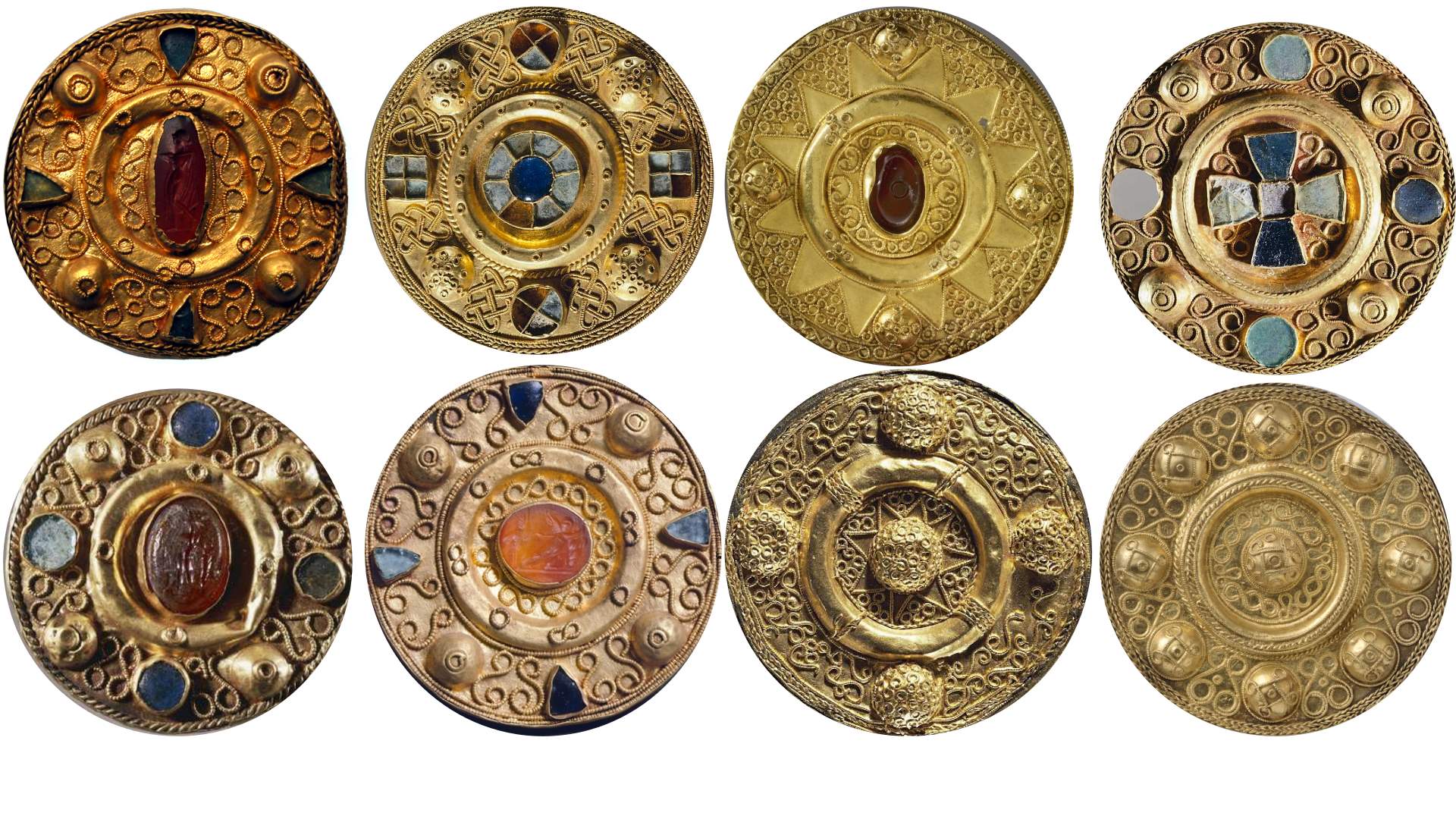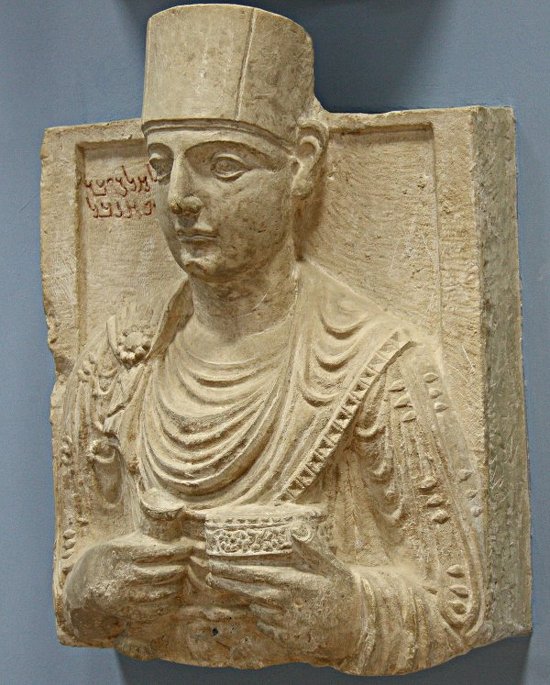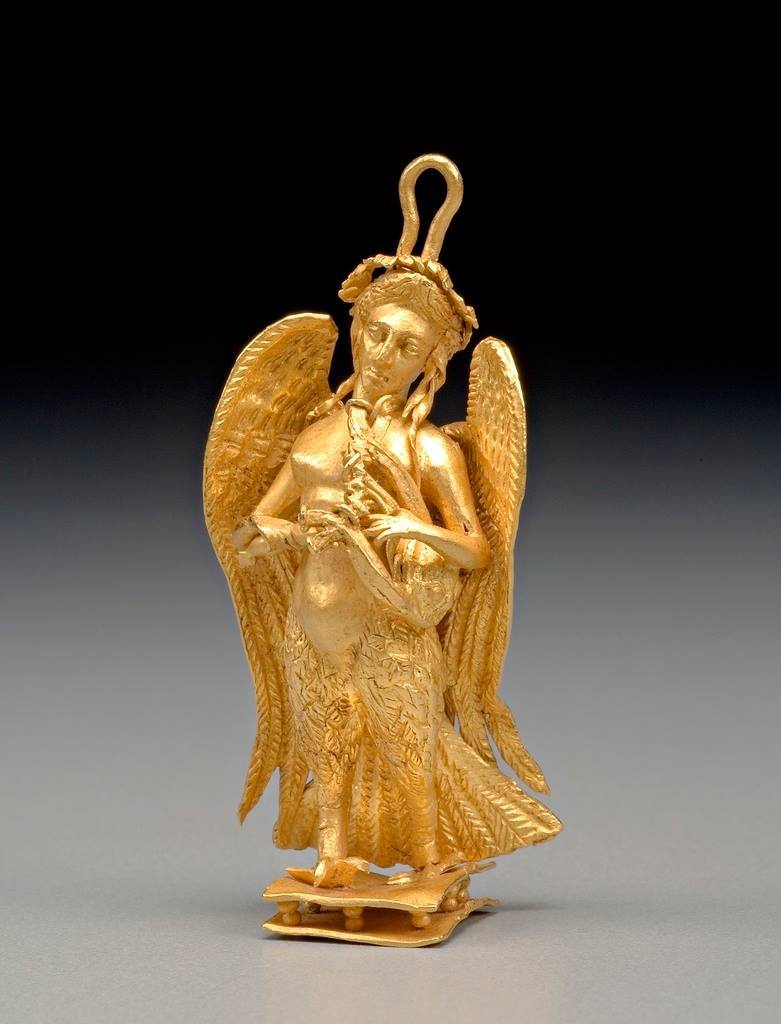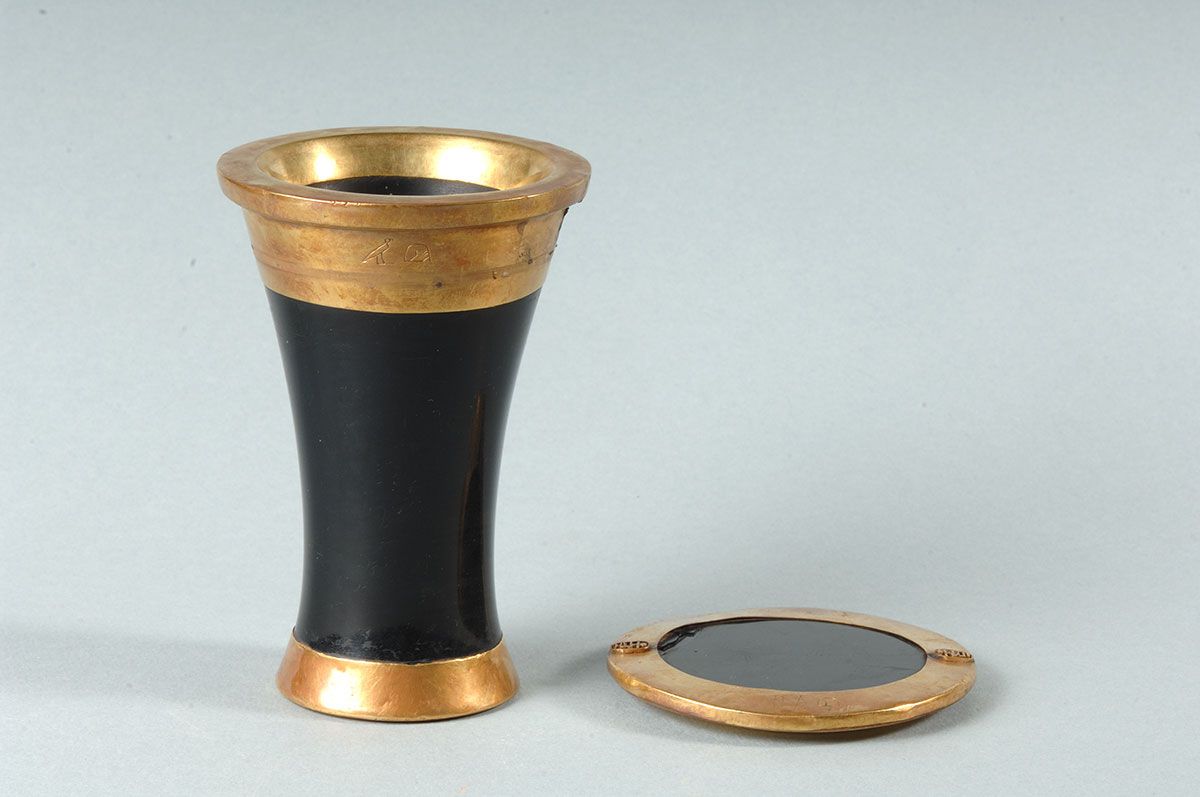Zestawienie starożytnych etui na amulety w formie cylindrycznych pojemniczków wykonanych jako biżuteria. W wielu amuletnicach znaleziono zwoje cienkich blaszek ze złota czy srebra z wyrytymi na nich magicznymi formułami, inne zawierały siarkę. Starożytni Grecy i Rzymianie przypisywali siarce właściwości talizmanu, używali jej do celów medycznych i w rytuałach oczyszczających. Dla Sarmatów siarka, jako symbol oczyszczenia związanego z kultem ognia, była pozostawiana w grobach razem z kredą, kawałkami gipsu i muszlami.
Amuletnice były noszone jako wisiorki lub części naszyjników, niektóre były przypinane do paska. Szeroko rozpowszechnione w czasach rzymskich, były noszone przez kobiety i dzieci. Możemy je zobaczyć na wielu “portretach mumii” z czasów, kiedy Egiptem rządzili Rzymianie [zobacz przykłady].
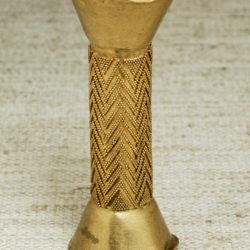
Amulet case, length 7.6 cm
Egypt, 1850-1800 BCE
The upper cap is removable.
British Museum

Phoenician gold amulet case, 8th-3rd century BCE
British Museum [museum record]

Gold Pyxis – a small vessel that most often contained cosmetic products
5th century BCE; Kukova Mogila mound, Duvanlii village, Plovdiv region, Bulgaria

Gold pyxis, H 2.5 cm, W 3 cm, weight 27.9 g. 4th-3rd century BCE, “Ormankov Grob”, Tremnik village, Negotino Municipality, North Macedonia
[read more]

1st century BCE, Židovar, Serbia [read more]
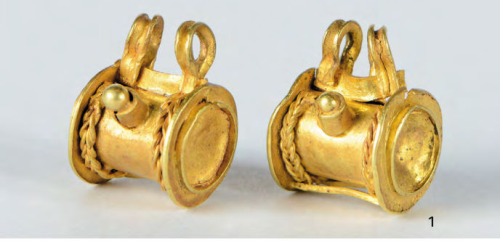
Źródło: Sergey Voroniatov, Some remarks about finds from the burial mound excavated by N.I. Petrik in 1900 // Antiquities of the Northern Black Sea Region, the Caucasus and Central Asia. St. Petersburg, 2024 https://www.academia.edu
____________________________
Two gold pendants in the shape of barrels, Sarmatian burial, 2nd/3rd century, Kuban region.
Dwie złote amuletnice – wisiorki w kształcie beczek z zatyczkami mają szerokość 1.3 cm. Pochodzą z sarmackiego kurhanu z II/III wieku ne odkrytego nad brzegiem środkowego biegu rzeki Kubań .
Prototypami tej biżuterii były najprawdopodobniej gliniane naczynia i drewniane beczki. Ta forma naczyń mogła trafić do świata sarmackiego z Azji Środkowej.

Źródło: Sergey Voroniatov

diameter: 2,0 cm; in the Hermitage

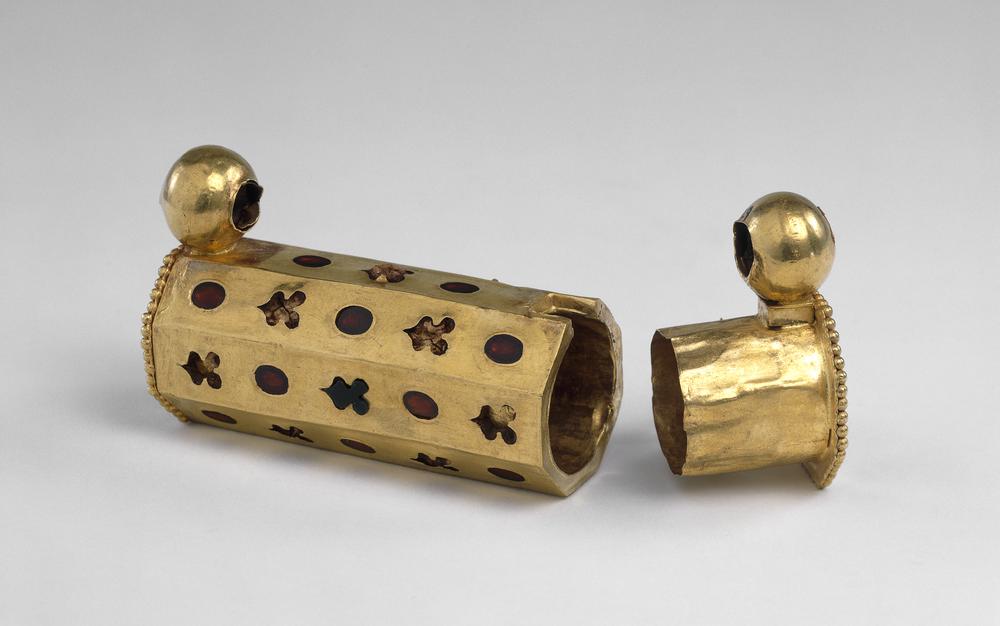
amulet – container British museum
Gandhara, 2nd-3rd century; length 8 cm
gold, garnet, serpentine


Amulet from State museums in Berlin from the 2nd-3rd century Egypt. The chased decoration shows two snakes in crowns, which may be a reference to the figures of Isis and Serapis. An amphora between snakes, birds and fish around.
The underside is decorated with a geometric surface pattern; the reverse bears a mirror-image Greek inscription with a protective formula. An amulet is 3.5 cm long.
Farther reading:
Notes on the furniture of children’s tombs in Greco-Roman Egypt: associated furniture and furniture depicted [Remarques sur le mobilier des tombes d’enfants dans l’Égypte gréco-romaine: mobilier associé et mobilier représenté]
Marie-Dominique Nenna https://books.openedition.org/pccj/1376

Syria Roman period, 4th century; length ~5 cm
“Cylindrical four-bail case, closed with opening at one end (cap). Object entirely decorated with granulated patterns.
5 groups of large granules arranged in a pyramid.”
BNF
Frontowe 3 [Фронтовое, Frontovoe] to miejsce pochówku Sarmatów odnalezione na Krymie. Spośród kilkuset mogił, kilka żeńskich pochówków zawierało bardzo bogate wyposażenie, w tym oszałamiającą biżuterię. Odnaleziono między innymi kilka pięknie zdobionych złotych amuletnic datowanych na I-IV wiek n.e. [więcej przedmiotów z F3]
Amuletnica, Frontovoe 3
II-IV wiek n.e. Długość 2 cm, średnica 0,9 cm
ГМЗ ХТ. ИКАМ 36572/739
Pusty w środku cylindryczny wisiorek wykonany z cienkiej płytki, zapinany trzema klipsami przechodzącymi w pętle; końce amuletnicy są zamknięte.
Na froncie umieszczono dwa okrągłe kaboszony wykonane z niebieskiego szkła, otoczone skręconymi drucikami. Pozostałą powierzchnię zdobi filigran wypełniony pastą szklaną, niegdyś najprawdopodobniej niebieską.
Badanie wykazało, że wewnątrz amuletu znajduje się „zapieczętowana” substancja.
A hollow cylindrical pendant made of a thin plate, tightened by three clips turning into loops; ends are closed.
On the front side there are two round blue glass inserts surrounded by profiled wire. The rest of the surface is decorated with filigree. The inside of the amulet is filled out.
2nd-4th century. Length 2.0 cm; diameter 0.9 cm.
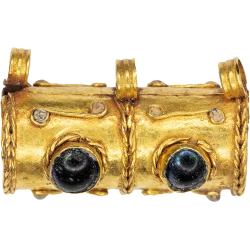

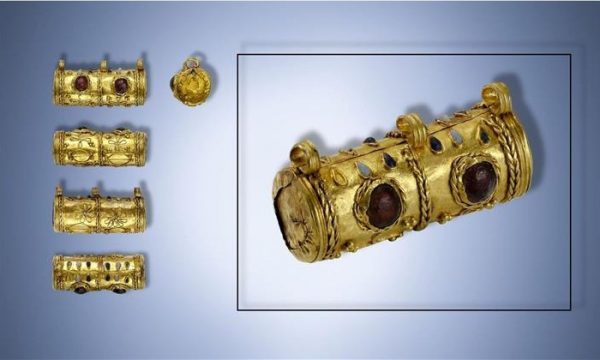
Amuletnica z pochówku nr 312, Frontowe 3
I-II wiek n.e.
Złota, bogato zdobiona i inkrustowana szklaną pastą amuletnica zawierała siarkę.


Amuletnica z pochówku nr 323, Frontowe 3
I-II wiek n.e.

Amulet z zapieczętowaną w środku przeklętą duszą zmarłego
Złota amuletnica znaleziona na Krymie, na cmentarzysku Kyz-Aul, w tym co pozostało z ograbionego wieki wcześniej pochówku. Datowana na II-III wiek.
Na jej tylnej stronie zostało wyryte magiczne zaklęcie:
καλὸc νõc ψυ[χὴ ?], ὤληθι [„Dobry umysł, du(sza?), zgiń!”]
co według rosyjskich archeologów jest zaklęciem czyjegoś umysłu i duszy.
“Zaklęcie umysłu, duszy przeklętego człowieka odnajduje się także w innych starożytnych zaklęciach – wyjaśnia kierownik wyprawy Paweł Getsko. „Wcześniej w nekropolii Kyz-Aul na Krymie archeolog Oleg Chevelev znalazł inny amulet z II-III wieku naszej ery z „zapieczętowaną” w nim duszą pewnego Prokliona.” [źródło https://crimea-radio.ru]
At the Kyz-Aul necropolis (Kerch Peninsula, Crimea, Ukraine) a new field season of the South Bosporan Archaeological Expedition [russian] began under the leadership of archaeologist Pavel Getsko. Almost immediately an interesting discovery was made – the tip of a military spear. The artifact was found in a layer of plunder waste next to a monumental stone crypt. Last year, in the same place, archaeologists from the Institute of Archeology of Crimea and volunteers from the Archeology Foundation found unique gold jewelry – antique amulets, one of which was engraved with an ancient magic spell.
[July 2023 https://vk.com/fondarchae]
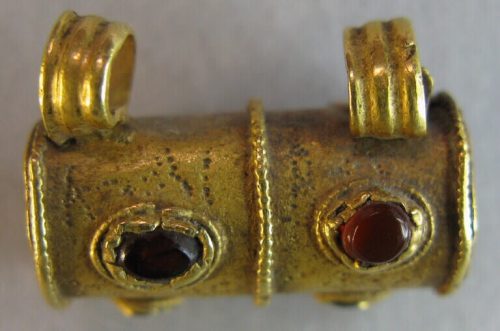
Chersonez [Chersonesos] Taurydzki, Krym
3 wiek n.e.; złoto, granat, turkus
Wybity grecki napis
- Notes on the furniture of children’s tombs in Greco-Roman Egypt: associated furniture and furniture depicted [Remarques sur le mobilier des tombes d’enfants dans l’Égypte gréco-romaine: mobilier associé et mobilier représenté], Marie-Dominique Nenna https://books.openedition.org/pccj/1376




